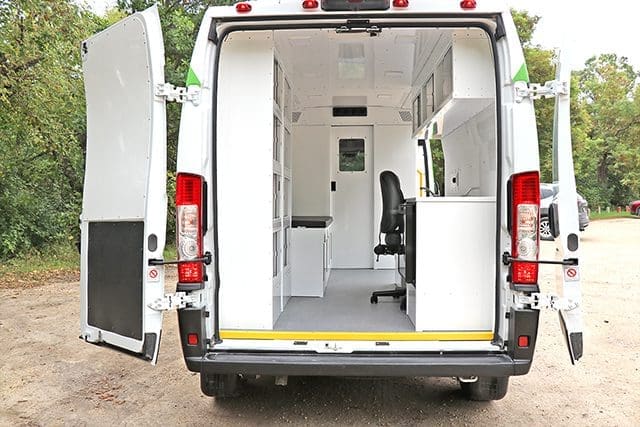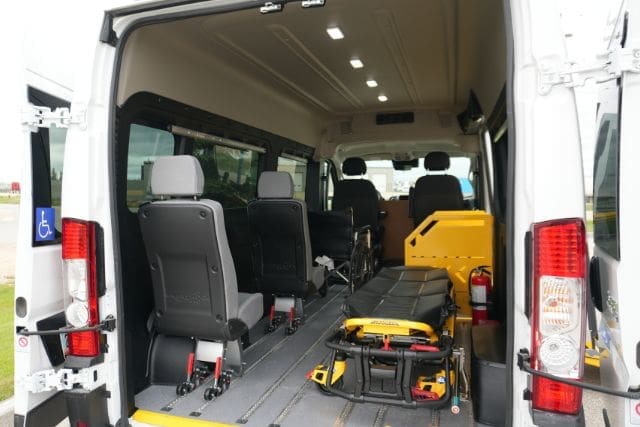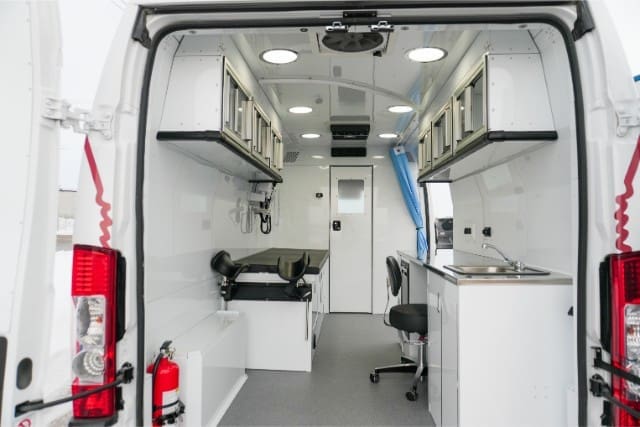Are you confused by how you’ll connect to the internet in mobile medical vans? Not having a reliable WiFi connection can lead to things like limited access to patient records, delays in telemedicine services, inability to update medical information, and breakdowns in communication.
Our team at MoveMobility works hard to create innovative solutions to help people all over the country with their healthcare needs. We know how important it is to have internet connectivity in your mobile medical unit, and that’s exactly why we’re writing this article.
After reading this article, you’ll have a better idea about how you’ll be able to connect to the internet in mobile medical vans. Internet service will allow you to communicate with your patients remotely, and do everything that requires internet as you can do in a basic healthcare office.
Why is it important to connect to the internet in mobile medical vans?
Technology is changing how people access healthcare. Because of that, connecting mobile medical vans to the Internet becomes a necessity. Let’s delve into why this connectivity is important in ensuring effective healthcare delivery.
1. Instant access to patient records
Having a reliable internet connection means instant access to patient records. This is like having a medical history book right at the fingertips of the healthcare providers. Quick access to information allows you to tailor care to each patient. Some of the information you might have to look up for your patients are:
- Allergies
- Previous treatments
- Ongoing medications
Instant access to patient records also helps in emergency situations. In emergencies, every second counts. Internet connectivity enables quick access to critical information for your patients. It enhances the speed and efficiency of emergency responses. This can make a significant difference in saving lives during critical situations.
2. Efficient telemedicine services
Imagine a doctor being able to provide medical advice from hundreds of miles away from the nearest town. With internet connectivity, mobile medical vans can tap into telemedicine services. Telemedicine services are like seeing a doctor through video calls on a computer or phone instead of going to the doctor’s office.
This is a game-changer, especially for those in remote areas who don’t have easy access to specialized healthcare.
3. Real-time updates for accurate records
Healthcare is a dynamic field, and patient information needs to stay current. Internet connectivity in mobile medical vans enables real-time updates to medical records. It helps to reduce the chances of errors and ensures that medical teams have the most accurate and recent information at their disposal.
4. Streamlined communication
Effective communication is the backbone of any successful mobile healthcare team. Internet connectivity facilitates seamless communication among medical staff. This helps to ensure everyone is on the same page. This is vital for delivering coordinated and efficient patient care.
5. Education and training opportunities
Mobile medical units are about treating illnesses and empowering communities through education. Internet connectivity opens the doors to online educational resources and training programs. This helps both your medical teams and the communities you serve stay informed and up-to-date.
6. Efficient appointment management
Managing appointments becomes a breeze with internet connectivity in mobile medical vans. It allows for smoother scheduling, reduced wait times, and ensures that patients get the care they need when they need it.
In essence, connecting mobile medical vans to the internet is about embracing technology. It’s about embracing the future of healthcare. It’s about breaking down barriers, reaching the unreached, and ultimately, saving lives.
What internet options are there with mobile medical vans?

When designing mobile medical vehicles for different communities, technology plays a big part in making them work well. Let’s see how technology helps these mobile units and what mistakes organizations should avoid when using technology in their designs.
Choosing how to connect: cellular vs. satellite networks
Deciding between cellular and satellite networks is an important part of the connectivity in mobile medical units. The decision between these two options depends on where the vans will be used.
Cellular networks: These are good for many places because they work well even if there are trees or buildings around. They’re flexible and reliable in various environments.
Satellite networks: These work over a larger area but need to be in open places without many obstacles. So, where you park the vehicle matters for good connectivity. An open parking lot would experience better signal strength than a dense forest.
Getting internet with mobile Starlink
To make sure everyone inside mobile medical units can use the internet, technologies like Starlink are a big help. Starlink is excellent for internet connectivity. It lets healthcare teams access medical records on their laptops inside the vans, as well as use telemedicine to help patients who can’t make it to the clinic.
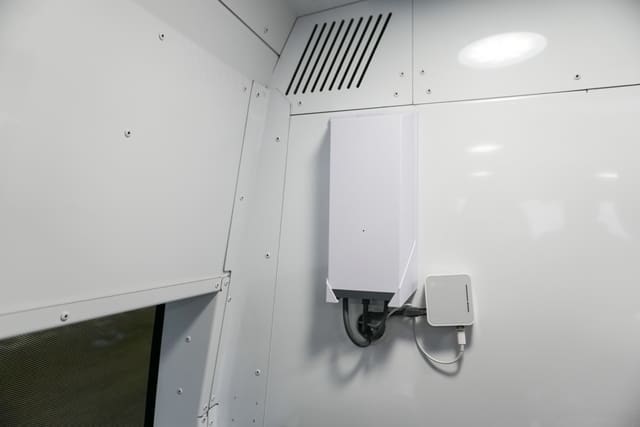
What are the pros of Starlink for mobile medical vans?
Global coverage: Starlink gives WI-FI access to places worldwide. You can use it even in remote areas where regular internet may not reach.
High speeds: Starlink provides fast internet, great for streaming, video calls, and other activities that need a lot of data.
Low latency: Starlink has a low delay, making activities like video calls and online activities smoother with less lag.
Easy installation: Setting up Starlink is easy. Anyone can install the satellite dish and connect to the internet without needing a lot of technical knowledge.
Resilience in natural disasters: Starlink is reliable even during natural disasters. It ensures internet access is available when regular infrastructure might not work. This is ideal if you’re taking your mobile medical van to remote areas of Canada.
Potential cost savings: Depending on the operational context, Starlink’s cost-effectiveness may result in potential long-term savings for mobile medical van operations. This is especially true in comparison to traditional connectivity solutions.
Unlimited data: Starlink’s plan offers you unlimited data usage. That means you don’t have to worry about overage charges if your mobile medical van team uses lots of data.
What are the cons of Starlink for mobile medical vans?
Upfront cost: Starlink may cost more at the beginning than some regular internet providers. This includes fees for equipment and a monthly subscription. Learn more about Starlink’s pricing.
Obstruction challenges: Starlink needs a clear view of the sky. Tall buildings or lots of trees can block the signal, causing connection issues.
Environmental concerns: Using many satellites for Starlink has raised worries about the
Dependence on weather conditions: Bad weather, like heavy rain or snow, can sometimes affect the Starlink signal. This can end up causing temporary disruptions in the internet connection.
5. Mistakes to avoid with internet technology
There are a couple of issues your organization should think about when deciding on internet technology.
1. Not thinking about the environment
Mistake: Not considering how your surroundings will affect the internet technology you’re considering.
Avoid: Before choosing satellite networks specifically, look at where your mobile medical unit will be. Also, check for things like trees or other things that might affect the signal.
2. Forgetting about areas with reliable connectivity
Mistake: Thinking all types of internet connectivity are the same.
Avoid: Understand your mobile medical unit’s connectivity needs when you’re out serving communities. While cellular networks are more flexible, in remote places, a good satellite option like Starlink might be better.
3. Ignoring keeping data safe
Mistake: Not making sure electronic medical records are safe.
Avoid: Use strong security like encryption technology to protect patient information and keep privacy standards.
4. Not making technology adaptable
Mistake: Using technology that can’t change.
Avoid: Choose flexible technology that can adapt to new healthcare needs and improvements. For example: If you’re considering outdated internet providers that only offer minimal data plans, it might be best to think about alternatives.
5. Underestimating training needs
Mistake: Thinking medical staff will know how to use new technologies without training.
Avoid: Train everyone well to make sure they know how to use the technology in the mobile clinic.
Technology makes a big difference in how well mobile medical units can help people with healthcare. Choosing the right network and using reliable technology like Starlink can make your unit successful.
What’s next for you?
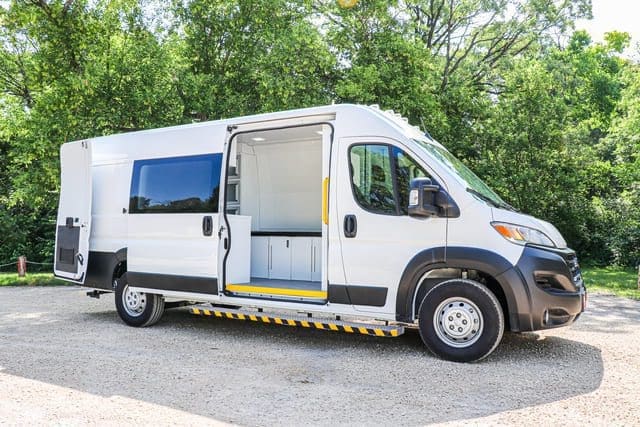
You came to this article wondering if and how you can connect to the WI-FI in mobile medical vans.
You learned about some of the common options for internet connectivity. We left you with some information on common mistakes to avoid when it comes to internet technology.
At MoveMobility, our goal is and has always been to make things easier for you as our potential customers. While your goal is to reduce barriers to healthcare for people who need it most, our job is to manufacture innovative vehicles that you can use to do exactly that.
From here, you should take a look at exactly how mobile medical vans break down barriers to healthcare by reading this article. You should also read through our article on the 5 steps to buying a mobile medical van. This article will guide you through the process from start to finish.


